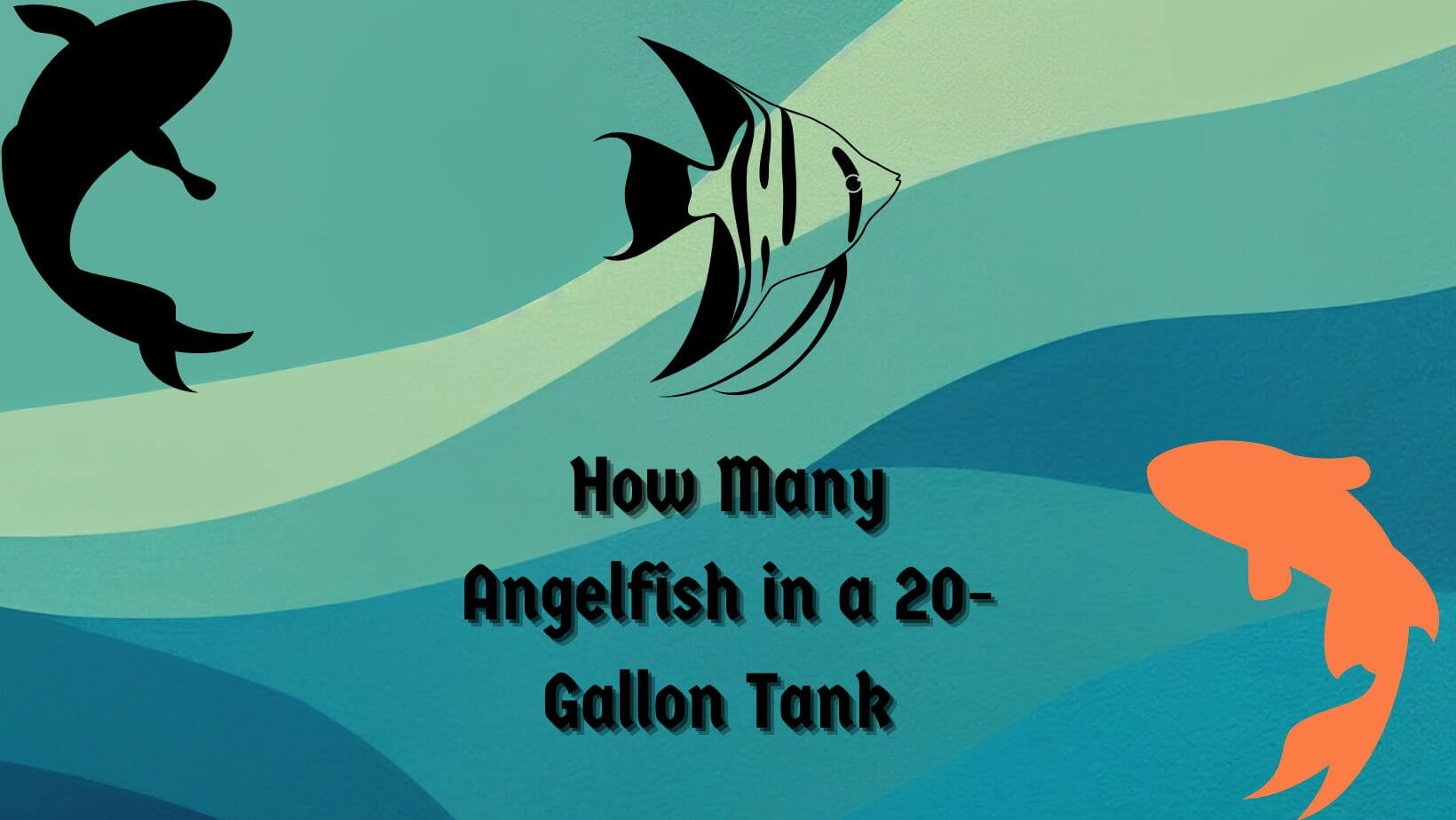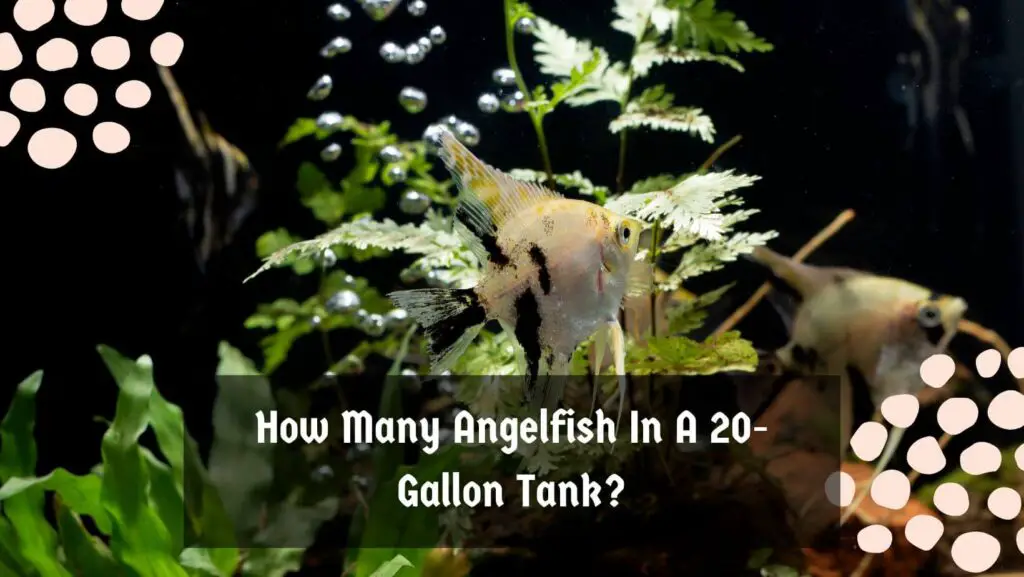
It is possible if you have a 20-gallon tank and want to have Angelfish in. However, it can be very confusing to know ‘how much angelfish in a 20-gallon tank’ you can have. If you need clarification about this, then don’t be so.
In this article, I will provide valuable insights into their preferences for adequate space and care to ensure their well-being.
In this article, you will explore ‘how many angelfish you can keep in a 20-gallon tank’ and the factors that may influence stocking numbers and tips to set up the tank.
Also, you must maintain a suitable environment for your Angelfish. But, before all of this, let’s begin with knowing how many Angelfish are in a 20-gallon tank.
How Many Angelfish In A 20-Gallon Tank?

As per the rule, you should have only a pair of Angelfish in a 20-gallon tank. Providing 10 gallons of water per Angelfish in a tank is best. Angelfish are known for their vertical swimming pattern, and too many in a 20-gallon can quickly lead to overcrowding, further causing stress, conflict, and other negative issues.
Since determining the number of Angelfish suitable for a 20 tank also requires consideration of both the tank’s size & the specific need of Angelfish, you should always be prompt to accumulate as many as possible.
Overcrowding can lead to stress and cause disease & poor water quality, ultimately harming your Angelfish to thrive. If you want to ensure that your Angelfish has enough space to thrive, consider the tank size & volume.
It is good to allocate approximately one gallon of water for every inch of Angelfish. If you consider the adult size of Angelfish, it can reach up to 6 inches and some even up to 8 inches. A 20-gallon tank can accommodate only a maximum of 3 angelfish species.
But, I usually recommend only having a pair of Angelfish for their health, well-being, & longevity. Even though much research supports this guideline and suggests that 20-gallon tanks can house up to 3 angelfish comfortably, I’ll still emphasize the importance of keeping only 2 to provide sufficient space for Angelfish to swim & establish their territory.
If you want to prevent overcrowding, aggression, and stress among the fish, it’s best to stick with a pair of Angelfish in a 20-gallon tank only. Also, you should consider the Angelfish size as well as compatibility.
When Angelfish Are Young, they may look small in size initially but can quickly grow & require more space as they mature. You must also consider their compatibility with other tank inhabitants to maintain a harmonious ecosystem.
Since a 20-gallon tank can only accommodate up to a pair of Angelfish, you should only keep that with them. However, consider getting a larger tank, like 40 gallons, to keep tankmates.
I recently shared an article on how many Angelfish are in a 40-gallon. Returning to the point, it’s best to avoid bate tankmates for Angelfish, no matter how large your tank is.
You should also consider checking our recent article on best tankmates for Angelfish to create a harmonious environment in a 40-gallon if required. Talking about a 20-gallon tank, a few factors may influence the stocking density of Angelfish in it. Therefore, let’s take a quick look at them.
5 Factors Influencing Stocking Numbers
Indeed many factors may influence the number of Angelfish you can keep in a 20-gallon tank. Therefore, I’ll recommend you understand all the factors carefully to make an informed decision and ensure the well-being of your Angelfish in a 20-gallon tank.
Bioload & Waste Production
Angelfish will also produce waste which can affect the tank water quality. Therefore, the more fish you have in a tank, the more waste will be produced. You should know that the ammonia & nitrate levels can quickly rise if you don’t pay attention to the waste management of the tank, leading to stress & health issues for your Angelfish.
The impact of stocking density on water quality is significant regarding the Angelfish tank size. According To Aquatic Veterinary Services, Overstocking will quickly lead to more ammonia & nitrate levels, indicating increased production.
If you notice alleviated levels of toxins, you should prevent compromising the health of Angelfish and other tank mates or tank inhabitants. I manage waste effectively by incorporating efficient filtration and doing water changes regularly as a routine.
I recommend you choose a high-quality filter with mechanical, biological, & chemical filtration capability to maintain a healthy environment for your Angelfish. Also, proper filtration can significantly reduce waste build-up and improve water quality.
Filtration & Water Quality
As I told you earlier, you must find a good quality reliable filtration to maintain a stable parameter crucial for the health & well-being of an Angelfish. Also, make sure to test the water parameters & regularly monitoring on temperature, pH level, ammonia level, nitrate level, & nitrite level, which are essential for the health and well-being of Angelfish.
Maintaining optimal water contemporary, including temperature & pH within the recommended range, will significantly reduce stress levels and improve health in Angelfish.
If you want to know about this kind of water parameter, consider reading our article on ‘ideal pH for angelfish‘ and ‘best angelfish water temperature.’ You should know that proper filtration is important in maintaining water quality and preventing the accumulation of harmful substances that may compromise Angelfish’s health.
Tank Decoration & Hiding Spots
You might also know that Angelfish appreciate a well-decorated tank that provides them with hiding spots & territories to claim as their own. Therefore, I suggest you incorporate live plants like Amazon sword or java fern, which will enhance your tank’s aesthetic looks and serve as a natural hiding spot for Angelfishes.
Also, you should know that the presence of live plants in Angelfish tanks will significantly reduce stress levels & increased exploratory behavior or foraging behavior as it mimics their natural environment.
Also, live plants will provide them with natural shelter, further stimulating and promoting their well-being. Consider creating crevices & caves using Rock formations & driftwoods where Angelfish can retreat & establish their territory. These kinds of Hiding spots effectively reduce stress and provide a sense of security for your fish.
Water Parameters & Temperature
Coming to the water parameters, you must maintain a stable water perimeter for the health & vitality of Angelfish as well. Ensure you regularly monitor the water parameters and adjust the temperature, pH, or another water perimeter, like hardness, to ensure a suitable environment for your fish.
If you want to know about Angelfish hardiness, consider reading our article ‘Are Angelfish Hardy.’ Angelfish are considered very hardy fish who have exhibited optimal growth & coloration when kept in varying water temperatures between 72-85° with a pH level ranging from 6.5 to 7.5.
These kinds of conditions mimic the natural habitat of your fish as well as promote their overall well-being. However, avoid sudden fluctuations in water perimeters that may cause stress or unwanted health issues in Angelfish.
As mentioned earlier, it is best to use a reliable aquarium heater and a thermometer to help maintain a consistent temperature range within the ideal limits.
Feeding & Nutrition
Lastly, you will have to provide a well-balanced diet for the health of your Angelfish to make them thrive, grow and lead a long life. Their diet should always consist of a combination of high-quality commercial fish food and occasional life or Frozen Food.
It would help if you considered feeding them a varied diet that includes commercial fish pellets or flakes formulated especially for Angelfish, along with occasional treats like live or frozen foods such as bloodworms and brine shrimps to promote optimal growth & coloration.
You must meet the nutritional requirement of Angelfish through a balanced diet. Therefore, ensure you provide them with various food sources and commercially available food for Angelfish that support their growth, nutrient requirements, coloration, and overall health.
Breeding Angelfish in a 20-Gallon Tank

It isn’t easy to breed Angelfish in a 20-gallon tank, but possible as long as you have only a pair in it. However, it would help if you planned after a few considerations when breeding them in a 20-gallon tank.
Pair Bonding & Compatibility
Angelfish belong to the Chichlidae family and are popular schooling fishes. However, if you want to know about angelfish schooling behavior, consider reading our article ‘Are angelfish schooling fish‘ and, if not, ‘What type of social engagement do they bear in their Natural habitat.’
Angelfish are known to form pair bonds for breeding purposes. Therefore you must observe their behavior and identify compatible tankmates for successful breeding. You should note that not all Angelfish will form pairs, so take your time & observation to find the right match.
The pair bonding behavior of Angelfish & their compatibility plays a crucial role in successful breeding. From my experience, Angelfish in pair often exhibit increased courtship behavior and successful spawning, especially when they are compatible in size, temperament, & coloration.
Once your pair has formed, they defend their territory and spawn eggs. Hence provide ample space & suitable tank decoration for the breeding pair to establish their territory.
Breeding Tank Setup
Now, you will also have to prepare a breeding tank for your Angelfish with a few adjustments you need to make. You must provide them with a flat vertical surface like slate or a piece of PVC pipe, which can serve as a suitable substrate for the Angelfish to lay eggs.
I have always used a clay pot to promote breeding. Also, you will have to maintain optimal water conditions like stable temperature, pH, and cleanliness to ensure successful breeding & well-being of the fry.
Conclusion
No doubt that keeping Angelfish in a 20-gallon tank will require careful consideration of space requirement water quality as well as compatibility with tank makes. However, adhere to the guideline mentioned above in this article and conduct further research.
You can create a suitable environment for Angelfish to thrive, live and breed for longevity. Also, be sure to remember that each Angelfish needs adequate swimming space, hiding spots, as well as a balanced diet.
Also, you should maintain stable water parameters & provide them with Suitable conditions for breeding if required. With proper care & understanding of their needs, you can always enjoy the beauty & elegance of Angelfish in your home aquarium for many years to come.
I have given my best to give you in-depth knowledge on the question ‘how many angelfish in a 20-gallon tank’. If you find this article helpful, then consider sharing it.
Your share is going to help many people learn about the question of how many Angelfish in a 20-tank can live happily. Do check my other helpful guide on angelfish care & facts. See you in the next post, till then, take care & goodbye.

